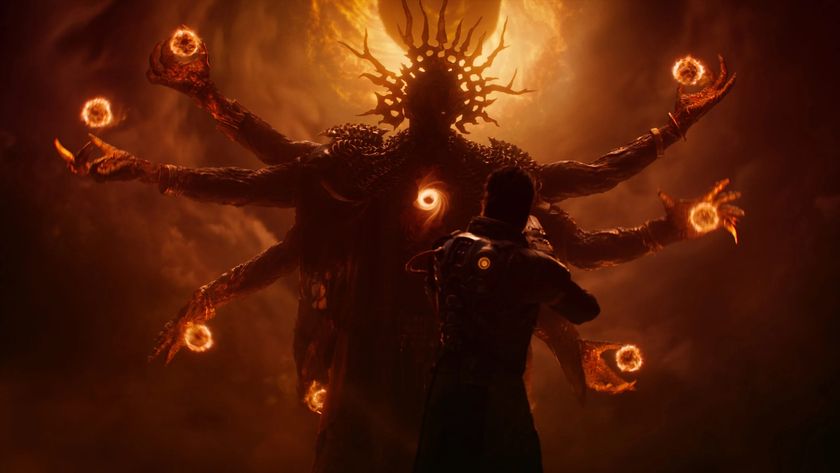The 2008 PC Builder's Bible
Find the best parts. Learn to build a rig from scratch and overclock it to kingdom come. PC Gamer shows you how
Q: Does it matter where I place the subwoofer?
A: A subwoofer produces tones that are so deep the human ear is unable to pinpoint their location, which is why the conventional wisdom is to put the sub anywhere you like. Your ears can’t tell the difference if it’s three feet behind you or five feet to your right. However, there will always be a “sweet spot” in your listening area where the subwoofer sounds best, so we
recommend playing a bass-heavy DVD (Saving Private Ryan’s opening sequence is a good choice) or some thumping music and then moving the subwoofer around the room while returning to your listening area to see how it sounds. Once you’ve pinpointed the “sweet spot,” invite your friends over to show your home theater off a bit! For tips on speaker placement, you also can read the article on the next page of this very issue.
2.1, 4.1, 5.1, and 6.1
Abbreviations used to denote the number of sound channels in a speaker system. The number before the decimal point indicates the number of regular audio channels and the number after the decimal point denotes the subwoofer (low-frequency) channel. For example, 5.1 means five regular channels and one subwoofer channel.
Q: What do I need to play movies in Dolby Digital surround sound?
A: In order to listen to true “discrete” Dolby Digital multi-channel audio on your PC, which is sound that is sent to separate channels from the sound source, all you need is a piece of hardware to decode the sound into its separate channels and a 5.1 speaker system. It’s really that simple. A Dolby Digital audio stream is a digital signal that includes six audio channels, but these signals have to be sorted by a decoder and sent to their respective channels in order to get that movie-theater sound separation where you hear bullets whizzing from the front channel to the rear channel. This decoder can either be built into the soundcard or the speakers, or it can be a separate add-on unit.
Q: How much power do I need?
A: A realistic assessment is that speaker systems that crank out 100 watts are sufficiently loud for home use, or 200 watts for a surround sound system. However, ultra-highwattage speakers that are capable of 500 watts or more sound better at moderate volumes since there is absolutely no stress to the speaker’s components at lower levels, whereas lesser speakers can become considerably stressed at lower volumes. The real reason for speakers to have high wattage ratings isn’t to actually use those high levels of output, but to ensure distortion-free playback at lower volumes. As a yardstick, the 2.1 Logitech Z-2300 speakers are capable of pumping 200 continuous watts and are pure sonic fury. We almost went deaf testing them.
Sign up to the 12DOVE Newsletter
Weekly digests, tales from the communities you love, and more
Q: I have a 5.1 speaker system, but am seeing advertisements for 6.1 and even 7.1 speaker systems now. Is it worth it to upgrade?
A: Although the addition of one little speaker behind you or two on the sides may not seem like it would make a big difference, it does. The traditional 5.1 surround sound speaker system sounds fantastic but leaves huge gaps in the sound field behind you and on the sides as well. The only catch to upgrading to 6.1 or 7.1 is that Creative Labs is the only manufacturer selling decent systems, but it offers both a budget 7.1 speaker system called the Inspire T7700 as well as high-end 6.1 and 7.1 systems as well. You can also buy Creative Labs’ S700 5.1 system, which is upgradeable to 7.1 for an extra $100. Also note that you’ll need a soundcard that supports 7.1 sound, but there are several models on the market currently that offer this feature.

SPEAKERS FROM SPACE
Q: I bought the Klipsch GMX speakers and have a Soundblaster Live. How can I get 5.1 sound out of them?
A: The Klipsch GMX-D5.1s were designed primarily for console gamers and include only digital 5.1 support. For PC gamers, this setup sucks, because most soundcards can send only a two-channel PCM signal digitally. If you want to get 5.1 sound out of your GMX-D5.1s, you’ll need an nForce motherboard or a soundcard that can output a Dolby Digital 5.1 stream. Unfortunately, only the Sound Blaster Audigy and Audigy 2 products can do that now. Your GMX-D5.1s are essentially 2.0 speakers, unless you have a properly outfitted soundcard.
WORRYING ABOUT WIRES
Q: What is the best way to lengthen speaker wires that are hard-wired into the back of the satellite?
A: The only way to deal with this tricky situation is to don your electrician cap and splice an extra length of wire into the main speaker wire. Grab a set of wire clippers/ strippers and clip the wire at any point.
Next, strip the cabling off the leading edge of the wires to expose the internal wires and connect the two sections of cable. Twist the new wires together and wrap the exposed portions of wire (the parts that used to be covered in cable sheath but are now entwined) with electrical tape and you’re done.
GOING COMMANDO
Q: Is it OK to remove the dust covers from my speakers? I like the look of the drivers and want to show them off!
A: It’s totally fine to remove the dust covers from your speakers. After all, that’s all they are- covers to keep dust off the drivers. In fact, some people like the look of the speaker drivers as opposed to the speaker grills, but to each his own. Be warned, though, that removing the safety covers exposes your speakers to errant flying objects, mischievous kitty cats and all sorts of desktop dangers. Personally, we like to protect our PC hardware, so we’d leave ‘em on.

Give your components a happy home
Head back to the table of contents
PC Gamer is the global authority on PC games and has been covering PC gaming for more than 20 years. The site continue that legacy today with worldwide print editions and around-the-clock news, features, esports coverage, hardware testing, and game reviews on pcgamer.com, as well as the annual PC Gaming Show at E3.
Most Popular







